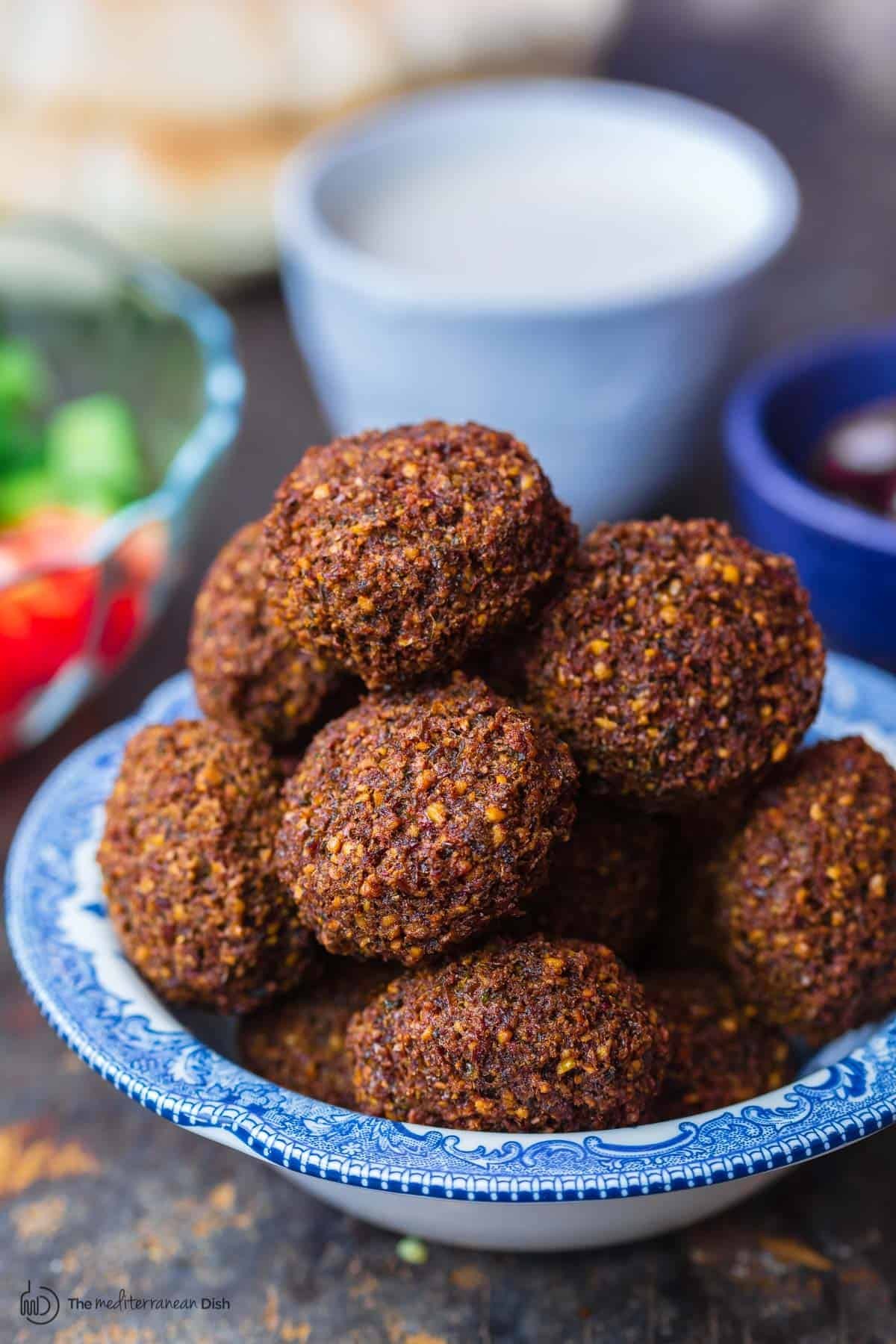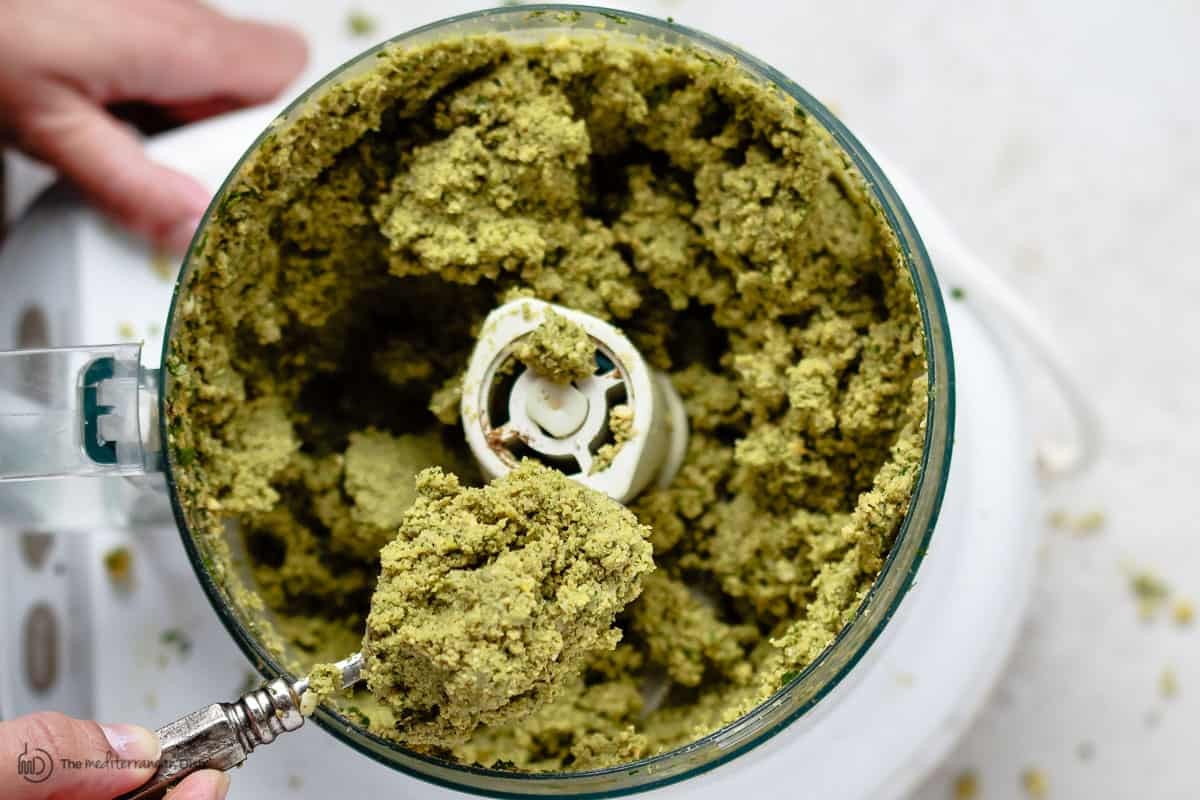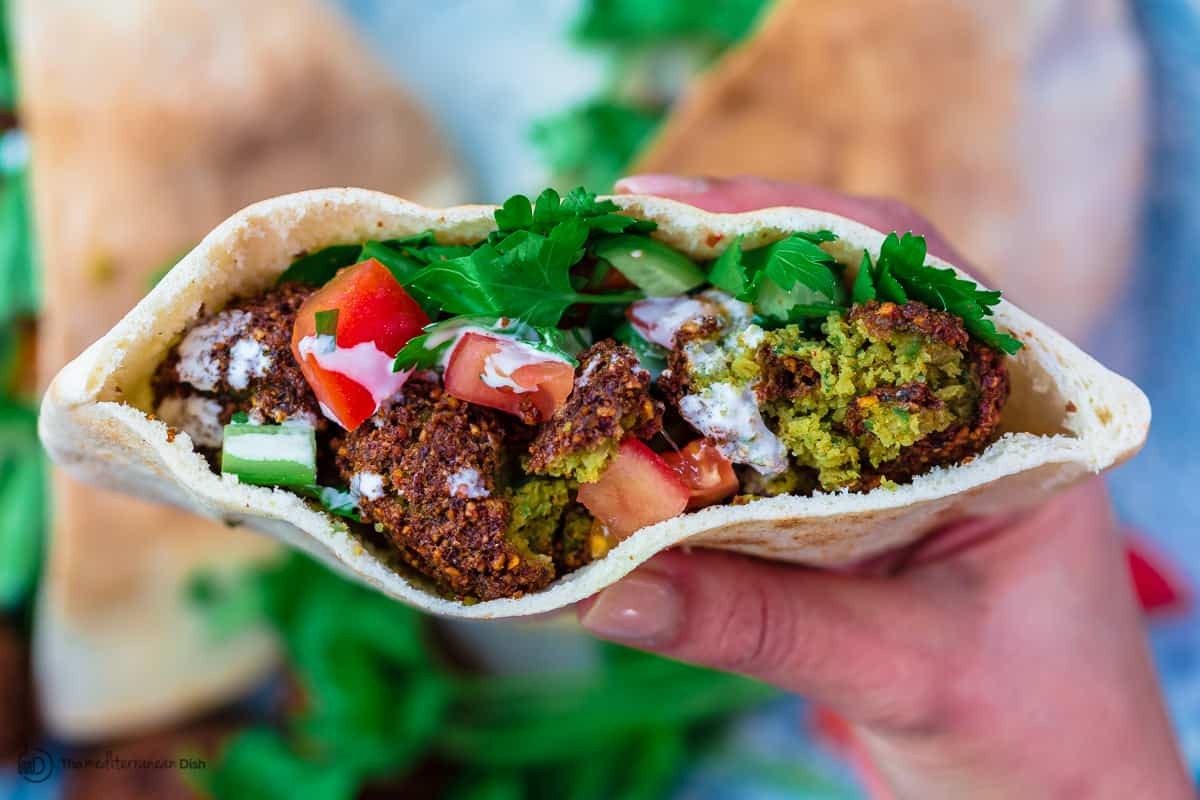Falafel is a delicious and popular Middle Eastern street food, and at WHAT.EDU.VN, we’re here to tell you everything about it! This deep-fried ball or patty is primarily made from ground chickpeas, herbs, and spices, offering a savory and satisfying vegan meal. Discover the essential components, learn how they contribute to the flavor, and explore variations of this beloved dish. Whether you’re a seasoned foodie or just curious, we will give you the knowledge to appreciate and even create your own falafel. Learn about the key ingredients that make falafel authentic, the nutritional benefits, and easy alternatives for dietary preferences.
1. What Exactly is Falafel?
Falafel is a traditional Middle Eastern dish, a type of fritter, composed of ground chickpeas or fava beans, mixed with herbs and spices. These ingredients are formed into small patties or balls and then deep-fried until golden brown. Often served in pita bread, falafel is a staple in Middle Eastern cuisine and has gained popularity worldwide as a delicious and versatile vegan option. It’s commonly enjoyed with tahini sauce, salads, and pickles.
1.1. Origin and Cultural Significance
Falafel is believed to have originated in Egypt, possibly as a meat substitute for Coptic Christians during Lent. From there, it spread throughout the Middle East, becoming a popular street food enjoyed by people of all backgrounds. In many Middle Eastern countries, falafel is more than just food; it’s a symbol of national identity and culinary pride.
2. What are the Main Ingredients in Traditional Falafel?
The main ingredients that make up falafel include dried chickpeas (or fava beans), fresh herbs, onion, garlic, and a blend of spices. These components work together to create the distinctive flavor and texture of authentic falafel.
2.1. Chickpeas or Fava Beans: The Base
Traditionally, falafel can be made from either chickpeas or fava beans. Chickpeas are the more common choice today, offering a slightly nutty flavor and a firm texture. Fava beans, on the other hand, provide a somewhat earthier taste and a creamier consistency.
2.2. Fresh Herbs: Adding Flavor and Freshness
Fresh herbs are essential for giving falafel its vibrant green color and refreshing taste. Parsley and cilantro are the most commonly used herbs, but dill, mint, or even green onions can also be added to create unique flavor profiles.
2.3. Onion and Garlic: The Aromatic Foundation
Onion and garlic provide a pungent and aromatic base that enhances the overall flavor of falafel. These ingredients add depth and complexity, complementing the other spices and herbs.
2.4. Spices: The Secret to Authentic Flavor
The spice blend is where the magic happens in falafel. Cumin, coriander, and cayenne pepper are typical choices, but other spices like cardamom, turmeric, or paprika can be added to customize the flavor. The right balance of spices is crucial for achieving that authentic falafel taste.
3. How Do These Ingredients Contribute to the Taste and Texture of Falafel?
Each ingredient in falafel plays a vital role in shaping the final taste and texture. Understanding these contributions can help you create the perfect falafel every time.
3.1. Chickpeas: Providing Texture and Nutty Flavor
Chickpeas are the key to falafel’s firm yet slightly crumbly texture. When ground, they create a base that holds the other ingredients together while providing a subtle nutty flavor.
3.2. Herbs: Adding Freshness and Brightness
Fresh herbs not only contribute to the vibrant green color of falafel but also add a refreshing and bright flavor. Parsley and cilantro offer a slightly peppery and citrusy taste, while dill and mint provide a more subtle and refreshing note.
3.3. Onion and Garlic: Enhancing Savory Depth
Onion and garlic introduce a savory depth that balances the other flavors in falafel. When cooked, they become sweeter and more mellow, adding complexity to the overall taste.
3.4. Spices: Creating Warmth and Complexity
Spices are what truly make falafel unique. Cumin provides warmth and earthiness, coriander adds a citrusy and floral note, and cayenne pepper gives a touch of heat. The combination of these spices creates a complex and aromatic flavor that is characteristic of authentic falafel.
4. What are Some Common Variations in Falafel Ingredients?
While the basic falafel recipe remains consistent, there are many variations in ingredients that can be explored. These variations often reflect regional preferences or dietary considerations.
4.1. Regional Variations in Spice Blends
Different regions often have their own unique spice blends for falafel. For example, some recipes may include a touch of cardamom or cinnamon for added warmth, while others may use more chili powder for a spicier kick.
4.2. Using Different Types of Beans
While chickpeas and fava beans are traditional, some variations may use other types of beans, such as black beans or lentils. These alternatives can alter the flavor and texture of the falafel, offering a new twist on the classic dish.
4.3. Adding Vegetables for Extra Nutrients
To boost the nutritional value and add extra flavor, some recipes incorporate vegetables like carrots, zucchini, or spinach into the falafel mixture. These additions can also help to bind the ingredients together, resulting in a moister and more tender falafel.
5. Are There Any Substitutions for Common Falafel Ingredients?
Whether you have dietary restrictions or simply lack a specific ingredient, there are many substitutions you can make without sacrificing the taste and texture of your falafel.
5.1. Gluten-Free Alternatives
Traditional falafel is naturally gluten-free since it’s made from chickpeas or fava beans. However, if you’re concerned about cross-contamination, be sure to use certified gluten-free spices and baking powder.
5.2. Vegan Options
Falafel is already a vegan dish, but it’s important to ensure that all ingredients are plant-based. Some recipes may include honey or other animal products, so always double-check the labels.
5.3. Low-FODMAP Adaptations
For those following a low-FODMAP diet, certain adjustments may be necessary. Onions and garlic can be replaced with green onion tops or garlic-infused oil. Chickpeas should be limited to a 1/4 cup serving per person, or fava beans can be used as a lower-FODMAP alternative.
6. What is the Best Way to Prepare Falafel Ingredients?
Proper preparation of the ingredients is essential for achieving the best falafel results. This includes soaking the chickpeas, chopping the herbs, and grinding the spices.
6.1. Soaking Chickpeas for Optimal Texture
Soaking dried chickpeas overnight is crucial for softening them and ensuring a smooth falafel texture. Be sure to drain and rinse the chickpeas thoroughly before grinding.
6.2. Chopping Herbs for Maximum Flavor
When chopping herbs, it’s important to use a sharp knife and avoid over-processing them. This will help to preserve their flavor and prevent them from becoming bitter.
6.3. Grinding Spices for Freshness
Grinding your own spices can significantly enhance the flavor of your falafel. Use a spice grinder or mortar and pestle to grind whole spices just before adding them to the mixture.
7. How Does the Cooking Method Affect the Final Product?
The cooking method can significantly impact the taste and texture of falafel. Deep-frying is the traditional method, but baking and air-frying are also popular alternatives.
7.1. Deep-Frying for Crispy Perfection
Deep-frying falafel results in a crispy exterior and a moist interior. It’s important to use hot oil (around 375°F) and avoid overcrowding the pan to ensure even cooking.
7.2. Baking for a Healthier Option
Baking falafel is a healthier alternative to deep-frying, as it requires less oil. Preheat your oven to 350°F and bake the falafel for about 20-25 minutes, flipping halfway through.
7.3. Air-Frying for a Quick and Easy Meal
Air-frying falafel is a quick and easy way to achieve a crispy texture with minimal oil. Preheat your air fryer to 375°F and cook the falafel for about 12-15 minutes, shaking halfway through.
8. What are Some Tips for Making the Best Falafel at Home?
Making falafel at home can be a fun and rewarding experience. Here are some tips to help you achieve the best results:
8.1. Using Dried Chickpeas for Authentic Texture
Avoid using canned chickpeas, as they will result in a mushy falafel. Dried chickpeas that have been soaked overnight are essential for achieving that authentic, slightly crumbly texture.
8.2. Chilling the Mixture for Easy Handling
Chilling the falafel mixture for at least an hour before cooking will make it easier to handle and prevent it from falling apart.
8.3. Adding Baking Powder for Fluffiness
Adding a small amount of baking powder to the falafel mixture will help to create a light and fluffy texture.
9. What are Some Popular Ways to Serve and Enjoy Falafel?
Falafel is a versatile dish that can be enjoyed in many different ways. Here are some popular serving suggestions:
9.1. In Pita Bread with Tahini and Salad
The most classic way to enjoy falafel is in a warm pita pocket with tahini sauce, chopped vegetables, and pickles.
9.2. As Part of a Mezze Platter
Falafel is a great addition to any mezze platter, alongside hummus, baba ganoush, and other Middle Eastern delicacies.
9.3. As a Topping for Salads or Bowls
Add falafel to your favorite salads or grain bowls for a protein-packed and flavorful meal.
10. Frequently Asked Questions About Falafel Ingredients
Here are some frequently asked questions about falafel ingredients:
| Question | Answer |
|---|---|
| Can I use canned chickpeas for falafel? | It’s best to avoid using canned chickpeas, as they tend to make the falafel mushy. Dried chickpeas that have been soaked overnight will give you the best texture. |
| What herbs are traditionally used in falafel? | Parsley and cilantro are the most commonly used herbs in falafel, but you can also add dill, mint, or green onions for a unique flavor. |
| Can I make falafel without gluten? | Yes, falafel is naturally gluten-free since it’s made from chickpeas or fava beans. Just be sure to use certified gluten-free spices and baking powder. |
| How can I make falafel healthier? | You can make falafel healthier by baking or air-frying it instead of deep-frying. You can also add vegetables like carrots, zucchini, or spinach to the mixture for extra nutrients. |
| Can I freeze falafel? | Yes, you can freeze uncooked falafel patties for up to a month. Just place them on a baking sheet lined with parchment paper and freeze until solid, then transfer them to a freezer bag. You can cook them directly from frozen by frying or baking. |



Making falafel at home is a delightful culinary adventure, allowing you to explore the vibrant flavors and textures of Middle Eastern cuisine. Whether you’re a seasoned cook or a beginner, understanding the essential ingredients and techniques will help you create the perfect falafel every time.
If you’re eager to discover more exciting recipes or have any burning questions about food and cooking, don’t hesitate to visit WHAT.EDU.VN. We provide a free platform where you can ask any question and receive quick, accurate answers from our community of experts.
Unlock Culinary Secrets and Satisfy Your Curiosity!
At WHAT.EDU.VN, we’re committed to providing a space where curiosity is celebrated and knowledge is freely shared. Whether you’re seeking cooking advice, recipe inspiration, or answers to any question that sparks your interest, we’re here to help.
Do you have questions?
- Are you struggling to find reliable answers to your cooking questions?
- Do you need quick and easy solutions for your culinary dilemmas?
- Are you looking for expert advice without the hefty price tag?
WHAT.EDU.VN is the answer!
We offer:
- A free platform to ask any question you can imagine.
- Fast and accurate answers from knowledgeable experts.
- Easy-to-understand information suitable for all ages.
Join our community today and experience the joy of discovery!
Visit us at WHAT.EDU.VN and unlock a world of knowledge.
Contact us:
- Address: 888 Question City Plaza, Seattle, WA 98101, United States
- WhatsApp: +1 (206) 555-7890
- Website: WHAT.EDU.VN
Embrace the opportunity to learn, share, and connect with a community that values curiosity as much as you do. Ask your question now and let what.edu.vn be your trusted source for answers.